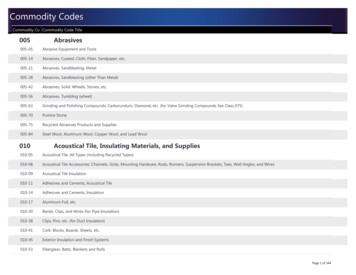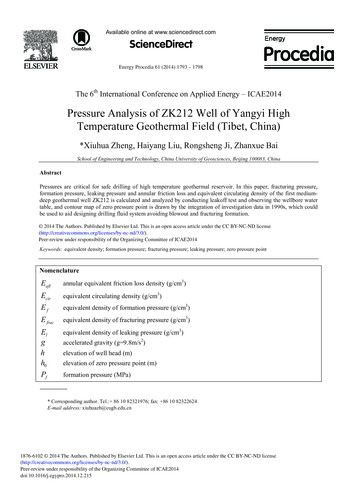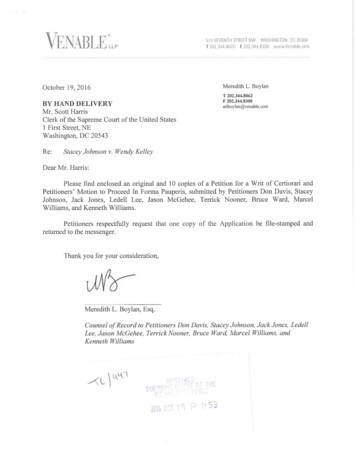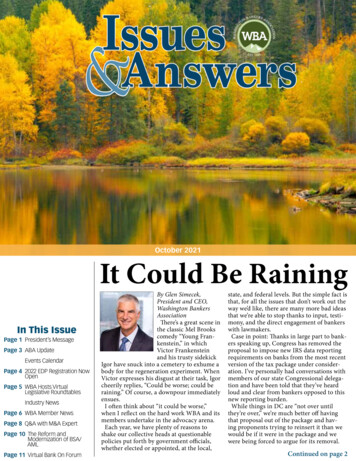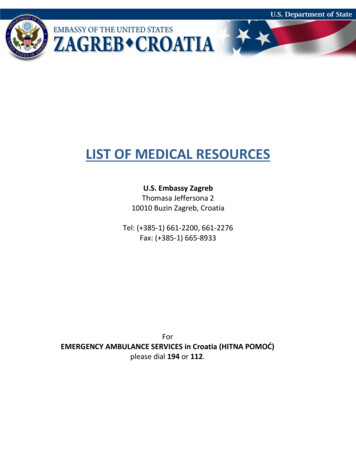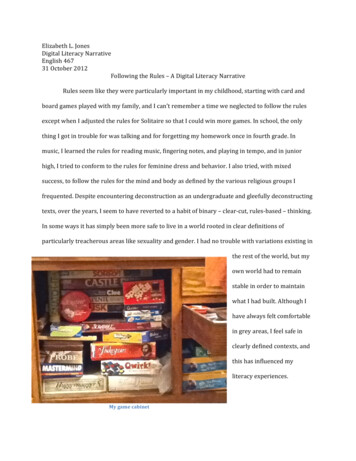
Transcription
DOCUMENT RESUMEED 344 467AUTHORTITLESPONS AGENCYPUB DATENOTEPUB TYPEEDRS PRICEDESCRIPTORSIDENTIFIEPC,FL 020 250Alatis, James E.State University System of Florida Foreign Languageand Linguistics Program Review.State Univ. System of Florida, Tallahassee.Feb 92240p.; Some pages of appendix may not reproduce welldue to filled print.Reports - Evaluative/Feasibility (142)MF01/PC10 Plus Postage.Adjunct Faculty; American Sign Language; BachelorsDegrees; Class Size; College Admission; CollegeCurriculum; College Faculty; *College Second LanguagePrograms; Degrees (Academic); Doctoral Degrees;Educational Quality; Higher Education; InstitutionalCooperation; International Educational Exchange;Language Enrollment; Language Proficiency; Languages;*Language Teachers; *Linguistics; *Majors (Students);Masters Degrees; Program Design; Program Evalua .Ion;State Legislation; *State Standards; State Surveys;*State Universities; Teacher Certification; TeacherEducation; Teacher Qualifications; Teacher Supply andDemandFlorida A and M University; Florida AtlanticUniversity; Florida Internat::onal University; FloridaState University; *State University System ofFlorida; University of Central Florida; University ofFlorida; University of North Florida; University ofSouth Florida; University of West FloridaABSTRACTThe third systemwide review of Florida's stateuniversity second language programs is reported. The executivesummary presents some institutional enrollment data and capsulizesfindings and recommendations for improvement. The report'sintroductory section addresses systemwide concerns and issues,including state policy initiatives and comments on the use of adjunctinstructors in university language classrooms, interdepartmentalcollaboration within universities, interinstitutional andinternational program collaborative efforts, necent statelegislation, role of class size and oral proficiency in the qualityof language instruction, and the place of American Sign Language inlanguage teaching programs. Reports on individual institutions(University of Florida, Florida State University, Florida A&MUniversity, Univeralty of South Florida, Florida Atlantic University,University of West Florida, University of Cantral Florida, FloridaInternational University, and University of North Florida) follow.The concluding section offers systemwide comments andrecommendations. Appendixes include: the Association of Departmentsof Foreign Languages administrative policy statement; reproducedarticles on joint Japan/United States language education programs; anarticle on the implications for teacher education and certificationof a Florida court decision; a report on optimum language class size;and professional association materials concerning languageproficiency standards. (MSE)
Nti4414FOREIGN LANGUAGESAND LINGUISTICScrz1 1UOFvce 131pepapriwern OF EDUCATX)01ducatIonsi Herseoin-t arta improvemvrtOFSOUOCES INFOAMATIONPROGRAA/1 FtENTIEWth.s Ocx ',mem ovvs Open reproduced asrecs.-go Porn ole pavIson nr 01Qpnzat on,gintitolgr Woo,changes Nave been mac* treposourttoo quzptvunorrivpOP,h,(els stater/ tn,t clot uPCon/S .4 ,*refupsom othe,(34men, CjCi n(ltOF Rt pos,Por, or'PceIpRERM'SSiON TO REPRODUCE THISGRANTED BYMATER L HASTO THE EDUCATIONAL RESOURCESINFORMATION CENTER {ERIC)"-44N."'"Ionswomms.00** P.-STATE UNIVERSITY SYSTEMOF FLORIDAFEBRUARY, 1992BOR 91-3efeMommemwmrsemimmmee.BEST COPY AMIABLE 2ataemmeommove.".".,
STATE UNIVERSITY SYSTEM OF FLORIDAForeign Language and LinguisticsProgram ReviewSubmitted byJames E. Alatisi DeanSchool of Languages and LinguisticsGeorgetown University
TABLE OF CONTESTSPrefaceExecutive SummaryiiiSystemwide Introduction & Recommendations1University ReportsUniversity of FloridaFlorida State UniversityFlorida A and M UniversityUniversity of South FloridaFlorida Atlantic UniversityUn:/ersity of West Florida.University of Central FloridaFlorida International UniversityUniversity of North Florida.Systemwide Summary & 3.D4.D5.ADFL Policy StatementJoint Japan/US Education EnterprisesOpportunism Seen in Education VenturesU.S. Campuses in Japan Losing AppealJapanese advertisement for UWF programPrinciples of Good PracticeA List of U.S. Institutions in JapanThe Standard Bearer.SLL Statement on Optimum Class SizeACTFL Proficiency Guidelines 1986Interagency Language RoundtableProficiency Testing in LCT LanguagesACTFL Chinese Proficiency Guidelines.215464718191102110129134
PREFACEIt is my honor to submit to the Board of Regents of theState University System of Florida the Foreign Language andLinguistics Program Review. This is the third time that Ihave been asked to perform this review.I am flattered by thedemonstration of faith which my colleagues in Florida haveshown in entrusting this important responsibility to me.Naturally, this process could not have been completedalone or even by a small group of people working in a vacnum.Instead, my fellow consultants and I have been fully supportedby the Office of the Chancellor and by each of theUniversities we visited. Special mention should be made ofRoy McTarnaghan, the Executive Vice Chancellor, whose faith inand adherence to the review process has led to the growth andimprovement of post-secondary education in Florida. GerryMiller, the Program Review Coordinator, was unfailinglyhelpful, patient and supportive; without his assistance, thisreport would never have been completed. In addition, theUniversity Consultants and I were impressed with andappreciative of the assistance of the University Coordinatorsand Program Review University Contacts. Of course/ we aremost grateful to all the faculty members, administrators,staff members and students of the State University System ofFlorida. Although too numerous too mention, this review wasmade easier by their candor and made worthwhile by their goodwill.This report follows the same format which I have used inthe past. The Introduction addresses systemwide concerns andissues. The reports of each of the University Consultantsfollow in their entirety. The xsport concludes with mysystemwide comments and recommendations. This last sectiondraws upon not only my own experierce and impressions, butupon the reports of my learned colleague consultants.Finally, I have included several documents in the form ofAppendices, which I hope will be of interest to those who willcontinue the process of which this review is but a singleelement.James E. Alatis, DeanWashington, D.C.June 6/ 1991School of Languages and LinguisticsGeorgetown University
EXECUTIVE SUMMARYIn 1991, a systemwide program review of SUS degree programs in foreign languages and linguisticswas conducted, with Dr. James E. Alatis, Deim of the School of Languages and Linguistics atGeorgetown University serving as the lead consultant. The SUS currently has 36 bachelor's, 20 master's,and 4 doctoral programs in foreign languages and linguistics.Florida has for many years pursued an active policy on foreign language education. These measureshave included reveral laws which have encouraged the development of international education programs,among them the Office of International Education, a Commission on International Education, and theFlorida Linkage Institutes, of which the Florida-Costa Rica Linkage Institute at FSU, and the FloridaBrazil Institute at UF have particularly strong records of activity. Other areas of strength reside withinthe SUS. For example, UF's Department of African and Asian Languages and Literal has establisheda modelof effective interdisciplinarycooperation. FSU is involved in several forms of interdepartmentalmajors, and its international Florida-Florence program enjoys a national reputation. FAMU hasestablished a Center for Translation Services, the result of a 472,000 grant obtained by a facultymember. USF publishes the well-respected scholarly journal, the Umaagamiterly. FAU teaching isof the highest order, and research has produced six book-length studies in the past five years. UWFfaculty all remain research-active, and the University Research Professor brings an internationalreputation in the field of modem Hispanic literatures and cultu-es. UCF summer programs are successfulin Canada, Germany, Italy, Spain, and the USSR, and the University has demonstrated its conamitment tointernationalism by hiring a Director of International Programs. FIU has established a high quality MAprogram in Linguistics as a result of the 1986 Program Review. UNF has established a high quaFty BAin Spanish and has installed a state-of-the-art language lab.These activities are all commendable and point to a continued progress in the area of foreignlanguages. However, if the SUS is to maintain its prominence in foreign language instruction and tomake the best opportunity of these initiatives, it will be imperative that its institutions address thefollowing concerns:fi i
For Consideradon by the Board of Regents and Universities:the practice of1. To help meet the large enrollments in foreign languages, universities have adoptedof adjuncts to full-time faculty is high at somehiring adjuncts to teach foreigm languages. The proportionuniversities, and it is strongly recommended that the university campusesreduce the numbers of adjuncts.foreign2. The two administrative units most directly involved in the production of Florida'sIt is ,ssential thatlanguage teachers are the Colleges of Arts and Sciences and the Colleges of Education.however, this is not the case in thethe relationship between the two colleges be a good one; too often,seeking to extend the international iange3. It is admirable that many of the universities are activelyformal ties to foreign countries theyof their programs. However, if universities are going to exploreunderstood by bothmust be especially careful that the terms of the agreement stated or implied are clearlysides.4. The Florida Consent Decree, filed in 1990 on behalf of K-12 students of limited Englishproficiency to ensure their rights to educational programs and services, has raised '.oncerns andchallenges in regard to the role to be played by the SUS universities in responding to the magnitude of theproblem.5. Class size directly affects the quality of language instruction: the smaller the class, the moreintensive the exposure to the language and the better the results. If Florida is seriously committed toquality languagc instruction, care must be taken that class size and contact hours be given a higherpriority than seems to be the case on many campuses. Further, a minimum standard proficiency scalebased on performance criteria should be adopted.The following graphs portray enrollment of majors and matriculation trends for both the SUS as awhole and individual universities.iv
I':: %,.4-.'I''j.If :.11"1I1M.td,".D0i.IIa:IISC1,4 A:,.,6Z.'s,r"- '''', '1411A, kc,"\;.,ieCV1'.,FNc/v, :;;N:"*,.i.,:.11.,. .: 14Vge-i.V.;\''itt.,t.,
UF Enrollment: Languages & a mmmiBachetoes19861987Mastees1988sige Ph.D.UF Dogrel's Conferned: Languages & LinguisticsBaCheioesPhD.Ma Stites919891990
FSU Enrollment: Languages and Linguistics110198319841985198719861988198919900, Bachelor's 4,-- Masier's -1- Ph.D.FSU Degrees Conferred: Languages & r.11186-87[1'87-88Bachelors88-89Master'svii89-90- Ph.D.90-91
USF Enrollment: Languages and helors 0-- MastersUSF Degrees Conferred: Languages & Linguistics86-8787-8889-9088-89Bachelors ----- Masters-71190-91
FAU Enrollment: Languages & " Bachelor's198819891990Master'sFAU Degrees Conferred: Languages end helor'sMaster'six1 2.
UWF Undergraduate Enrollment: Languages 81 891990UWF Bachelor's Degrees Conferred: Languages and Linguistics86-8787-8889-9088-89.1390-91
UCF Undergraduate Enrollment: Languages and 819891990UCF Bachelor's Degrees Conferred: Languages and 89-9090-91
t0,3 Vagt0139 COOVattgusges and UW4AstIcst)o-gA
UNF Undergraduate Enrollment: Languages & Linguistics1983198419851986198719881980UNF Degrees Conferred: Languages and Linguisticswimm Bachelor's 40 Master's1990
SYSTEMWIDE INTRODUCTION AND RECOMMENDATIONSThe State University System (SUS) of Florida has onceagain chosen a propitious moment to conduct a review of itssystemwide programs in foreign language education.Not onlydoes this review correspond to perceived educational needs onthe state level, it also responds to concerns over foreignlanguage education at the national level.It alsodemonstrates the SUS's responsiveness to the internationalevents which provide the wider context in which the nation'sforeign language competencies are continually re-evaluated.This combination of intrinsic and extrinsic factors--theintrospective nature of the SUS's definition and redefinitionof "humanistic" education, juxtaposed with its response to thepolitical and cultural events which affect (and at timesassail) it from without, are part of a university system'sdialogue with its past and its future.On the local level, a combination of factors bearsdirectly on foreign language education.The State of :loridais one of the more active states in passing foreign languageeducational policy, and thus:(a)Since 1979, the State of Florida has adopted severallaws encouraging the development of international educationprograms, among them the Office of International Education, aCommission on International Education, and, as part of the117
FOREIGN LANGUAGE AND LINGUISTICS PROGRAM REVIEWFlorida Linkage Institutes, a number of exchange programsbetween universities in Florida and universities in theCaribbean, in Latin America, and abroad.(b)To offset the shortage of qualified personnel inforeign language education, the state established the Criticalto actualTeacher ShortagA Pr9gram, which provides incentivesand prospective foreign languages teachers in the form ofgrants, loan forgiveness/ and tuition reimbursement.SummerInstitutes provide 60 contact hours of instruction to teacherswho are either currently out of the field, or are pursuinsadditional certification.In 1986 (also the year of Florida'slast systemwide program review), 21 school districts offeredsummer institutes for a total of 459 (potential) foreignlanguage teachers.Adlunct instructors, holding bachelor'sdegrees in a foreign language, may be hired as part of theVisiting School Scholars Program, and retired teachers may behired as substitutes (without losing benefits).(Thedrawbacks to a too-liberal use of adjuncts is discussed insection 1 below.)(c)New K-12 certificotion standards require prospectiveforeign language teachers to complete a minimum of 30 semesterhours in specific language areas and to pass a test in thespecific language they will teach.(d)The Foreign languase in Elementary Schools ProgrAm(FLES) began in 1982-83/ with the participation of 13 school
SYSTEMWIDEINTRODUCTIONANDRECOMMENDATIONSdistricts; by 1988-89, FLES operated in 27 districts, with atotal enrollment of 60,232 students.(e)Beginning in 1987, applicants to state universitieswere required to have two foreign language credits foradmission.Irk 1990 the foreign kanauaaerequirements were aiendedIdmismionsOne particularly interestingfeature of the amendments was the decision to allow AmericanSign Language (ASL) to fulfill a foreign language requirement--this is discussed further in section 6. Another feature,which strengthens the foreign language requirements,stipulates that not more than 5 percent of universityapplicants may be exempted from the foreign languagerequirement at the time of admission; however, students mustfulfill the requirement prior to completing 60 credit hours atthe university.These amendments have a trickle-down effect:K-12 foreign language instruction relies to a certain extenton demands and expectations at the college level.In certaincircles it takes very little to undermine an educationalresolution whose benefits are not easily measured, and certainof the on-site evaluations reported the lingering attitudethat foreign language instruction is considered to be not apositive advantage but a necessary evil.As this overview suggests, Florida has for many yearspursued an active, even aggressive, policy on foreign languageeducation.State efforts- -like .tny human efforts--are often31 14
FOREIGN LANGUAGE AND Ltricuisncs PROGRAMpredictable problem isbeset with difficulties, and oneeducation are as common as alligatorsfinances: cutbacks inSome university budgetsin a swamp--and just as dangerous.In a climate ofhave been cut by as much as 5 per cent.programs is problematic,drastic reductions, where maintainingThis reportexpanding them is virtually out of the question.recommendations, and it does socriticismandmakes specificthan we like to admit inin full awareness that more oftensuggestionseducation, the bottom line is money; however, thethat going backwards alsoare offered with the full awarenesshistory of commitment to foreigncosts money. Given Florida'sthe particular compositionlanguage education, and given alsohoped that administratorsof its residents, it is much to beless than whatwill not use budgetary setbacks to justifyparticular its comprehansiveFlorida's educational system, ininstruction, has come to need orproglam for foreign languageexpect.Systemwide recommndations1.use and abuse.in foreign languages,To help meet the large enrollmentshiring adjuncts touniversities have adopted the practice ofThe practice isteach foreign languages in the university.increase in Floridaunderstandable, given the dramatic42
lYSTEMWIDE INTRODUCIION AND RECOMMENDATIONSenrollment and the immediate needs of foreign languagestudents; however (as the individual reports indicate), it istoo often the case that (a) the proportion of adjuncts tofull-time faculty is dangerously high, and (b) the effect onboth full-time faculty (overloads of course and committeework) and adjunct instructors (marginal involvement in thedepartment, and second-class citizen status) can be detri-mental to the needs and the welfare of the department and,consequently, of foreign language instruction itself.Thus,the use of adjuncts, intended to be remedial, is in danger ofbecoming an illness in itself, worsening the situation offoreign language instruction.It is strongly recommended thatthe university campuses attempt some reduction of the numbersof adjuncts.It may be of some consolation to realize the SUSis not alone in this problem: the ADFL report entitled "PolicyStatements on the Administration of Foreign Language Depart-ments" reviews the dangers of excessive reliance on part-timefaculty, stresses the potential damage to foreign languageprograms as a whole, and makes specific recommendations forlong-term departmental planning (the report is included asAppendix A, see especially "Use of Part-Time Faculty").2./ntexmal ggalabarAtign:Colleges of Arts and Sciences andCollegeg of gagcation.Two language needs exist side-by-side in American521
FOREIGN LANGUAGE AND LINGUISTICS PROGRAM REVIEWeducation:one is the need to expose monolingual Englishneedspeakers to foreign language education; the other is thespeakers into theto incorporate bilingual or non-EnglishEnglish-language educational system.Given Florida's critical teacher shortage, both inforeign languages and in English to speakers of otherlanguages (ESOL); an increase in the number of qualifiedlanguage teachers is crucial.The SUS will continue to play acritical role in teacher education.The two administrativeunits most directly involved in this process of teachereducation are the Colleges of Arts and Sciences (A&S) and theColleges of Education (COE).Given the importance of teacherstandards [see section 4 below, with reference to the ConsentDecree], it is essential that the relationship between the twocolleges be a good one.As many individual reports suggest,however, too often this is not the case.Methods coursestaught in the COE must be reflective of and responsive to theneeds of foreign language faculty.COEs may be territorialand resent intrusion by foreign language departments on whatthey consider to be their exclusive turf.Linguisticallybased methods courses taught by experts in foreign languagedepartments should be accepted as eligible substitutes for oneof the methods courses required for certification.A model of collaborative effort seems to be in place atFAU as well as at USF:the key seems to be a successful622
SYSITMWIDE INTRODUCTION AND RECOMMENDATIONSnersonal liaison between the COE and the A&S.In this regard, it is particularly painful for me to seethe need to reiterate that native-language expertise does notautomatically constitute teaching expertise.That a personspeaks fluent English does not make that person a qualifiedEnglish instructor.This argument has its corollary in theuse of native speakers of foreign languages.trap, and an easy one to fall into:This is an oldon the surface the groundlooks perfectly safe; the hidden dangers become evident onlyonce the fatal step has been taken.I cannot stress enoughthe importance of a responsible attitude toward professionalteacher preparation, particularly since the native-languageexpertise fallacy seems to be operative (I hesitate to say"rampant") on so many Florida campuses.3.External Collaborations:ylorida Linkaae Institutesand,prouosed collaboration itith gapan.The Florida Linkage Institutes, created within theDepartment of Education, have, as their primary purpose(according to the'legislative decree), the development ofstronger economic and social ties between Florida andstrategic foreign countries through the expansion ofcooperative research and technical assistance, exchangesbetween both students and faculty, cultural exchanges, and theenhanT.ement of language skills in both the universities ofFlorida and in those of the foreign countries.7At present,
WIFOREIGN LANGUAGEAND LINGUISTICSPROGRAM REVIEWhave been developedagreementsimtitutethe following linkageCollege System withCommunityand thebetween the SUSeducation in other designatedof higherorganizations(University of FloridaInstitutecountries: Florida-BrazilFlorida-Costa RicaCollege);Communityand Miami-DadeValencia CommunityUniversityandStateInstitute (Florida(Florida InternationalInstituteCaribbeanCollege); FloridaFloridaCommunity College);BeachUniversity and DaytonaFlorida and BrevardofWest(UniversityCanada Institute(University ofInstituteFlorida-JapanCommunity College);College); FloridaCommunitySt. PetersburgSouth Florida andUniversity of Southofthe(New CollegeFrance InstituteCommunityand Miami-DadeUniversity,StateFlorida, FloridaAtlanticInstitute (FloridaFlorida-IsraelCollege);Florida-West AfricaCollege);CommunityUniversity and BrowardUniviarsity of NorthUniversity,(Florida A&MInstituteJacksonville). IfCollegeatCommunityFlorida, and Floridapotential, they musttheirfullto achievethe institutes arecontingent uponfunding,sufficientcontinue to riceiveIn addition, moremeasures.meeting a set of accountabilitythe SUS regarding thethroughouteffective communicationinstitutes provide fortheservices and opportunitiessupport isinstructionalanddevelopmentresearch, facultystrongly recommended.
SYSTEMWIDE INTRODUCTION AND RECOMMENDATIONS/t is admirable that many of the universities areactively seeking to extend the international range of theirprograms.However, a caveat is in order, with particularregard to plans put forth by the University of West Floridaand the University of Central Florida to establish programswith Japan.Unfortunately, other universities have haddifficulties in their attempts to introduce exchange programswith Japan.One element in these exchanges cannot be ignored:if universities are going to look for outside funding, theymust be especially careful that the terms of the agreementstated or implied are clearly understood by both sides.In this regard, the Fall 1990 ACTFL Newsletter featuredan article on exchanges with Japan that is pertinent toFlorida's exchange program (see Appendix Bl;article from The Cbrgnigle ofsee also theHigher Education,Appendix B2).The article reports on a study undertaken by the Institute ofInternational Education (IIE), which investigated a number ofAmerican-Japanese higher education partnerships which havebeen formed over the last decade.The findings of the I1B areof direct relevance to current plans of certain SUS campuses,and should be seriausly considered.I summarize:(1)Japanese partners are usually for-profit businesses, a factorwhich can cause difficulties for tax-exempt Americaninstitutes; (2) although these programs claim to fostergreater mutual understanding between American and Japanese9
FOREIGN LANGUAGE AND LINGUISTICS PROGRAM REVIEWstudents, in reality, the students rarely mix; and(3)Japanese students--and more especially, their parents (see thearticle from Asahi Evenina Aews, Appendix 83) are shocked todiscover that payment of tuition does not automatically ensurea degree.In light of the report's statement:"The newdevelopments in Japan-U.S. higher education represent the fullrange of folly, fraud, mediocrity, and excellence that cangrow in such a setting," the SUS is well advised to beexceedingly careful in any plans and negotiations forexchange.Given this background, it is easy to see thatoffering a non-credit ESL program in Japan such as the UWPKobe venture should be undertaken only with extreme care.Similarly, the proposed 600,000 Japanese donation toward anew building on the UCF campus must be considered an offerwitb eirings attached, and UCF should be very clear as to thelength and width of those strings, and of their possibilitiesfor entanglement.In addition to the articles already mentioned, I wouldrefer especially to the "Principles of Good Practice inOverseas International Education Programs for Non-U.S.Nationals" and to "A Listing of U.S. Institutions of HigherEducation in Japan," both put out by the Council onPostsecondary Accreditation (see Appendix 85 and 1216).1026
SYSTEMWIDE INTRODUCTION AND RECOMMENDATIONS4.Efigant lngialatim.The Flori4a Consent Decree, filed in 1990 on behalf of K12 students of limited English proficiency (LEP) to ensuretheir rights to educational programs and services, has raisedconcerns over ESL certification and in-service training.State standards for full teacher certification are still inthe process of being worked out; however, it is theabsorption, by a grandfather clause, of teachers already inthe public school system which provoked major concern.Teachers without adequate preparation in ESOL might nonetheless be certified de facto because of this grandfather clause,which embraces teachers who have worked with LEP students fortwo years, regardless of their preparation.If a district decides to teach basic subject areas usingESOL strategies, teachers may be qualified under one of threeoptions:(1) subject certification (grades 6 12), plus 60hours of in-service or 1 semester hours of ESOL methodologies;(2) subject certification plus ESOL endorsement; (3) subjectcertification, plus full ESOL coverage.Two interpretationsof the subject-area requirements are currently beingdiscussed.One is that only teachers in academic ESOL courseswill be required to take the in-service or coursework.Theother is that any teacher with LEP students in their classeswill be required to take the ESOL in-service or coursework.The second interpretation would mean that all teachers with1127
FOREIGN LANGUAGE AND LINGUISTICS PROGRAM REVIEWbe required to have ESOLLEP students in their class willthe Statetraining. The relevance of this legislation totheUniversity System becomes more apparent when one considersimplications of providing the required in-service training.teachers whose classesSame school districts have over 1000contain LEP students. Two basic and interrelated questionspresent themselves:(1) Who will provide the in-servicetraining, and (2) Who will provide the money to provide theteachers/training? The questions can only be answered asDOE begin toadministrators, university faculty, and the stateDecree/implement the requirements mandated under the Consentimplications for thebut the answers will have far-reaching(An excellent summary of the implications of theprofession.Bearer," which IConsent Decree may be found in "The Standardhave included as Appendix C.)Institute. has, asThe proposed International Languagelanguageits primary purpose, the responsibility to provideand related instruction to persons interested in internationalfostertrade and international affairs. The intent is toStateinternational trade, development, and relations with theof Florida and foreign countries.An important question is,"What is the role of the foreign language, ESOL and foreigntheir faculty) in thelanguage teacher education programs (anddevelopment of such an institute and the achievement of itsgoals?"Only by involving from the onset the specialists in122S!A
SYSTEMWIDE INTRODUCTION AND RECOMMENDATIONSthese fields at universities, community colleges, and schooldistricts will this question be answered and the goals of suchan institute be achieved.5.Quality of J.anauage instruction:glasks size and oralmroficiencvTwo major issues (a) class size and (b) methods ofproficiency testing were constant themes in the consultants'reports.The questions were addressed at length in the 1978and 1986 Program Reviews.Nonetheless, in light of therecurrence of these issues, I have chosen to reiterate herethe salient points of the discussion.(a)Class size.Stated in its most simp
Florida; University of North Florida; University of South Florida; University of West Florida. ABSTRACT. The third systemwide review of Florida's state university second language programs is reported. The executive summary presents some institutional enrollment data and capsulizes findings and recommendations for improvement. The report's

